| Article ID | Journal | Published Year | Pages | File Type |
|---|---|---|---|---|
| 4466787 | Palaeogeography, Palaeoclimatology, Palaeoecology | 2012 | 9 Pages |
Microbially induced sedimentary structures (MISS) result from the interaction between benthic microorganisms and sediments; MISS preferably form in upper intertidal to supratidal settings from the Archean to the modern. The identification of MISS in Neogene deposits of the Rio Negro Formation (Late Miocene to Pliocene), Rio Negro Province, Argentina, covering the transition from continental to marine facies (and vice versa), provides the base to refine the paleoenvironmental interpretation. The overall clastic paleocoast was differentiated into high-energy erosional domains and protected areas where MISS became preserved. However, during peak transgression also the initially protected areas experienced high energy sediment reworking. Because of the extent erosion in the high-energy coastal setting, the localized occurrence of tidal-flat deposits was difficult to recognize. The thin tidal flat deposits exhibit macroscopic and microscopic features that can be attributed to the interaction between microorganisms and sediment, such as cracks with upturned margins, sponge pore fabric, wrinkle structures, multidirected ripple marks, floating sand grains and so on. In addition, the biostabilization processes typical of substrates housing microbial mats led to the excellent preservation of vertebrate footprints that characterize these deposits.
► Macroscopic and microscopic evidence of MISS was found in the Rio Negro Formation. ► Occurrence of MISS has important paleoenvironmental and stratigraphic implications. ► Excellent preservation of the vertebrate footprints is related to the microbial mats.
